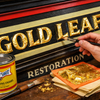Rabbit Skin Glue: How and When to Use It
- by Amanda Cochrane
Using traditional materials in the crafts of gilding, restoration, and fine art is valuable in preserving authenticity and high-quality results in craftsmanship. Rabbit skin glue, a time-honoured adhesive, remains a staple for professionals seeking authenticity and quality in their work. In this guide, we'll delve into the effective use of rabbit skin glue, offering practical advice on preparation, application, and suitable surfaces.
Rabbit Skin Glue: Understanding Its Role in Traditional Crafts
Rabbit skin glue is a natural adhesive derived from the collagen of rabbit hides. Its unique properties make it ideal for various applications:
- Gilding: Acts as a size to adhere gold leaf to surfaces.
- Canvas Preparation: Used to size canvases, preventing oil paint from deteriorating the fibres.
- Woodwork: Serves as a traditional adhesive in fine woodworking and restoration projects.
Its reversibility with heat and moisture allows for adjustments and repairs, a feature highly valued in conservation work. Rabbit skin glue offers excellent adhesion while remaining flexible enough to work across delicate or absorbent materials.
Because it is a natural protein-based glue, it works especially well on surfaces like raw wood, paper, and linen. It has been trusted by generations of artisans for centuries, particularly in Europe, and remains a go-to material for conservation studios and craftspeople aiming to maintain historical integrity.
Preparing Rabbit Skin Glue
Proper preparation is crucial for optimal performance. We offer both granulated and ready-prepared rabbit skin glue to suit your needs.
For Granulated Rabbit Skin Glue:
Start by soaking the granules in cold water. Allow them to swell for several hours or preferably overnight. This step is essential, as it ensures the glue fully absorbs the water and reaches the correct consistency when heated.
Once soaked, gently heat the mixture in a double boiler or glue pot until the glue has completely dissolved. It’s vital not to overheat the glue—keep the temperature below 60°C. Higher temperatures can damage the protein structure and weaken its bonding ability.
For Ready-Prepared Rabbit Skin Glue:
Our ready-prepared rabbit skin glue simplifies the process. Simply stand the container in warm water to liquefy the glue, and it’s ready to use. This option is particularly convenient for those who need a quick application without compromising on traditional quality.
Whether using granulated or ready-made options, always prepare only as much glue as you need for immediate use. Leftover glue can spoil quickly, especially in warm conditions, and is best discarded after each session.
Application Techniques
Applying rabbit skin glue successfully requires care and patience.
Surface Preparation: Ensure your surface is clean, dry, and free from dust or oil. The glue will not adhere properly to a contaminated or damp surface.
Brush Application: Use a soft, flat brush to apply a thin, even coat of warm glue. For gilding, the glue acts as a traditional size—once it reaches the right tackiness, the gold leaf can be carefully applied. Timing is key. Too wet, and the leaf won’t grip; too dry, and it won’t stick at all.
Canvas Sizing: In painting, rabbit skin glue is commonly used to size raw canvas. The glue creates a barrier that prevents oil paint from coming into direct contact with the fibres, which can lead to rot over time. Apply one or two thin coats, allowing each to dry thoroughly.
Drying Time: Allow the glue to dry naturally in a dust-free environment. Avoid forcing it to dry quickly with heat sources, as this can lead to cracking.
Some craftspeople also mix rabbit skin glue with chalk (whiting) to make a gesso ground for painting and gilding. This produces a beautiful, absorbent white surface that’s ideal for icon painting or traditional wood panel art.
Suitable Surfaces
Rabbit skin glue is compatible with many traditional surfaces:
-
Wood: It’s widely used in fine woodworking, musical instrument making, and antique furniture repair.
-
Canvas: As mentioned, it’s essential for sizing canvases in oil painting.
-
Paper and Parchment: Its reversibility and strength make it suitable for mounting and conservation work.
- Gesso Grounds: Combine with whiting to produce a smooth ground layer for painting or gilding.
It’s important to note that rabbit skin glue is not ideal for high-humidity environments or for bonding non-porous, modern materials like plastic or metal. As a hygroscopic substance, it can absorb moisture from the air, which may weaken the bond over time.
Rabbit Skin Glue: Storage and Shelf Life
Granulated rabbit skin glue can be stored for extended periods in a cool, dry place. However, once prepared, it should be used immediately. Any unused, liquefied glue should be discarded, as it does not keep well and may become unstable or develop mould.
Use small batches to avoid waste and always clean your brushes and pots with warm water immediately after use.
We pride ourselves on offering quality materials to support traditional craftsmanship. Rabbit skin glue remains one of the most trusted and versatile adhesives in our range, providing reliability and authenticity to every project.
If you have questions about selecting the right glue or want to discuss the best products for your work, our team is always happy to help. Contact us for expert advice and dependable supplies that support your craft from start to finish.
- Posted in:
- Rabbit Skin Glue






